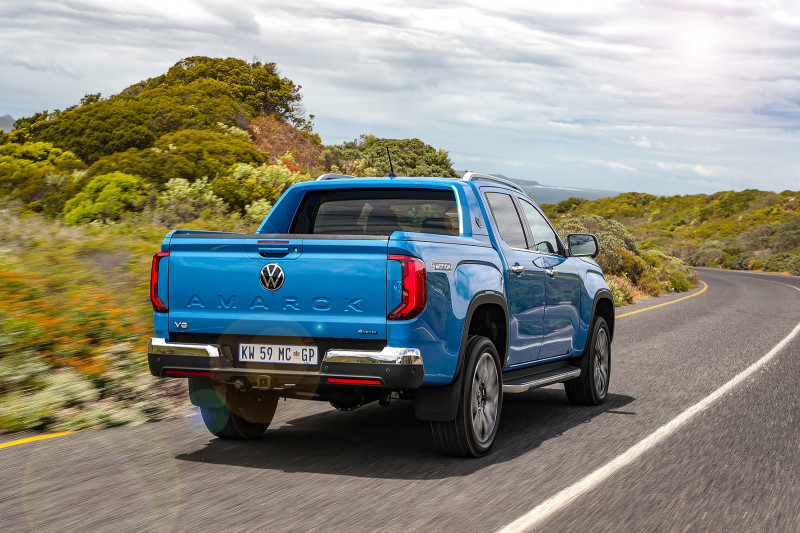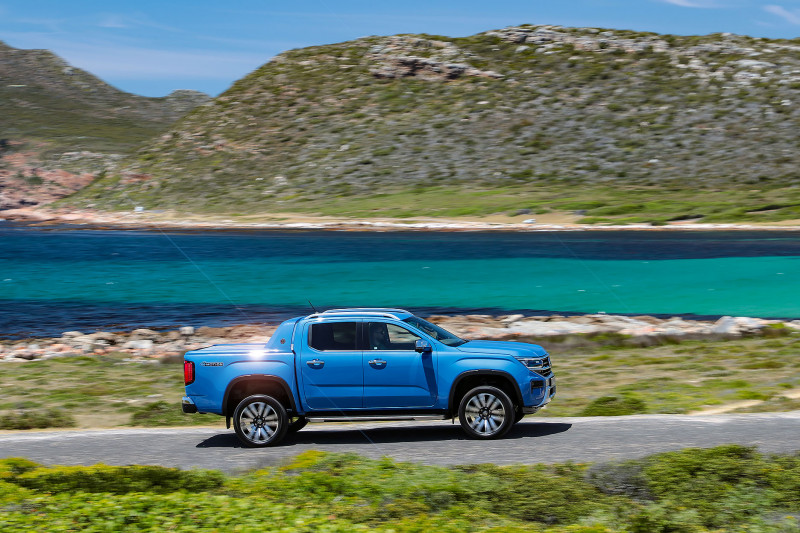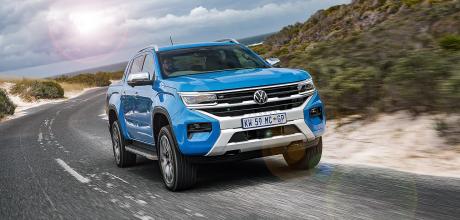2024 Volkswagen Amarok 3.0d V6 Aventura 4MOTION Double Cab
Co-development with the class-leading Ford Ranger was a great start, but VW’s new 4x4 is out to push further upmarket.
DEVELOPED WITH RANGER; CHARTS ITS OWN COURSE
Volkswagen’s second-generation dual-cab ute, due here in April, once again enters a fray dominated by the Japanese, yet this time it’s not doing so quite so singlehandedly. Amarok MkII was codeveloped with the latest version of the Aussie-American Ford Ranger: shared platform, shared drivetrains, shared technology. And shared roof, glass area, doorhandles, and side-mirror caps.

The shrewd decision to partner with Ford has allowed the Amarok to retain many of the virtues appreciated by fans of the original
Shared sales might be trickier, simply because, unlike Ford and other key rivals, VW Australia has chosen to eschew cab-chassis, 4x2, and single-cab sub-segments – throwing its entire marketing payload into the dual-cab 4WD category. 4x2 and single-cab versions have been created for other markets. Amarok pricing has yet to be finalised, but we know it will be higher across the range. And higher than that of the Ranger.
Volkswagen is pitching it as the segment’s ‘premium ute’, trading on a combination of upmarket interior and heavily loaded standard specification. Five model grades have been confirmed for Australia, with the next set of Walkinshaw-badged specials not expected until 2024.

The Adventura’s steering is quite superb, with an uncannily natural and meaty weighting
Every grade has, at a minimum, a large infotainment display (10 or 12 inches), wireless Apple CarPlay/ Android Auto, wireless phone charging, LED headlights, adaptive cruise control, lane-keeping aids, rear parking sensors, speed-limit notification, and nine airbags (five more than the previous Amarok).
A vinyl-floored Core returns as the base model, and the Life adds some more niceties before the mid-pack Style – tipped to be the most popular variant and expected to cost from mid to high-$60K before on-roads – ramps up the list of fancier features and exterior addenda.

The new-to-VW Pan Americana badge marks where the Amarok puts a touch of extra emphasis on off-roading with all-terrain tyres and softer suspension and introduces leather seating.
Aventura again denotes the flagship, fulfilling the road-biased brief with huge, 21-inch wheels – three inches up on the largest tyres currently available on the Ranger, although the incoming Ranger Platinum will adopt 20s.
The Pan Americana could start somewhere in the $75-80K bracket; the Aventura is anticipated to start above $80,000 – possibly above the $81,490 Walkinshaw W580S that was previously the most expensive Amarok.
Volkswagen’s pricing strategy isn’t helped by the Amarok’s production location in South Africa, which incurs a five percent import tariff where Ford Australia benefits from a free trade agreement with Thailand where the Ranger is built. Volkswagen Australia claims it will further differentiate the Amarok by offering a combination of factory and officially endorsed accessories from launch.
Inside, the new Amarok once again pushes the envelope for upmarket ute interiors. There are only a few elements of the Amarok’s cabin that are obviously shared with the Ranger – the ergonomically brilliant squeeze-to-open doorhandles, chunky gearshift lever, albeit with VW’s own leather covering, portrait infotainment screen, and a digital driver display with some variations from Ford’s skin.
Various design elements – such as the T-shaped dash, 3D-style vents, and rugged infotainment/mode shortcut buttons – plus an assortment of smart finishes achieve a distinctive look and for the Amarok’s cabin.
Style, Pan Americana and Aventura variants feature a dashboard plateau fully covered in artificial stitched leather – greyish brown in all our test cars – the same material of which is also applied to the upper door cards.
The Pan Americana adds material on the doors seemingly influenced by reptile skin. The middle sections of the doors, not just the armrests, yield to the touch, and smooth plastic inserts of various finishes are cleverly blended into the mix. The slightly rough black headliner is about the only notable disappointment.
The two-tone leather seats manage to feel both broad and supportive, offering an impressive level of sustained comfort over long distances.
As with the Ranger, the Amarok’s rear seat isn’t the most commodious in the dual-cab ute class, but there is respectable space, and deeply scalloped seatbacks aid knee clearance. There’s decent foot space under the seats and plentiful headroom, while air vents are welcomed as a first for the Amarok. Storage options include bottle-mould door compartments, seatback pouches, and cupholders in the centre armrest. The rear of the centre console featured 12V and 240V sockets, but the latter will be replaced by more useful USB-C ports for Australian customers.
In the back, Amarok’s tray continues to fit a Euro pallet courtesy of a 1624mm length and 1227mm between the wheelarches. Six load-lashing rings have a tensile load rating of 400kg, while a track system incorporates four 250kg-rated moveable clamps.
LED tray lighting is standard on all Australian Amarok models. The Pan Americana comes with a tonneau cover; the Aventura features an electronic roll cover. Maximum payload has also increased, from one tonne to just under 1.2 tonnes – one of the best figures in the segment.
There’s again a 3500kg braked towing capacity, while VW says the permissible total weight of vehicle and trailer has increased from 6 to 6.5 tonnes. You can also carry up to 85kg on the roof while driving, or up to 350kg when static – ideal for pitching a rooftop tent.
On the road, the original Amarok was a pioneer in many regards, including its refined car-like interior and driving position. This aspect hasn’t just been retained but seems to have been further emphasised.
The driver’s seat – powered from the Style upwards – can be adjusted to sit surprisingly low. The front seats feel like best-in-class contenders, with excellent shape, cushioning and bolstering from the entry Core up to the range-topping Aventura. The leathered Pan Americana and Aventura variants, in which we spent most of the two-day launch, proved immensely relaxing for hours behind the wheel. The Aventura is a particularly intriguing model, as the only Amarok to get its own (stiffer) front dampers, its own (faster) steering tune, and a set of huge, 21-inch wheels that dwarf those of any other variant.
The negative result of the first and third elements is a ride that is always firm, mostly busy, and sometimes jiggly. It tends to smooth out with increased speeds but generally feels like a set-up that could well struggle on typically scabby Australian roads.
There was an obvious contrast to the Pan Americana, with its softest-in-range suspension tuning clear despite launch models being fitted with 20-inch wheels rather than the 18s that will be the standard Australian spec.
A brief drive of a Style on 18-inch wheels provided another indicator of the improved ride that can be found elsewhere in the range.
On the positive side, the Aventura will hold the biggest appeal for any keen drivers who are looking to migrate from a passenger car or SUV to a dual-cab ute.
The flagship Amarok equips itself commendably well along curving country roads, keeping both lateral and vertical body movement in check. The steering is quite superb, with an uncannily natural and meaty weighting, and a responsiveness from the straight-ahead that makes it easy to point the Amarok exactly where you want.
As dynamically excellent as a well-engineered large SUV? Let’s not get carried away; there are still limitations to what can be done with a ladder-framed, leaf-sprung chassis.
The all-season Goodyear Wrangler HT 275/45R21 tyres grip strongly, refusing to squeal even under load in hairpins and making less noise than the wind around the side mirrors. There’s not quite the same crispness off centre in the Pan Americana or Style, with their slightly slower racks and slightly smaller tyres compared with Aventura, but the steering is still otherwise in the same impressive ballpark of the Ranger and BT-50.
Our time in a mid-range Style twin-turbo four-cylinder diesel was limited to an off-road course and a very short on-road drive.
That was still long enough to mark another similarity with the Ranger. It’s well worth paying the relatively small premium for the V6 diesel.
The smaller diesel is a good engine, no doubt, but the V6 is smoother, stronger, and more responsive. However, a Sport mode and paddle-shift levers would be particularly desirable with the V6.
As in the Ford twin, the six-cylinder is also linked to a permanent all-wheel-drive system where the four-cylinder diesels feature electronically selectable part-time set-ups.
Disappointingly, the Mustang-sourced 2.3-litre twin-turbo petrol engine – the most powerful engine with 222kW and set to be a no-cost option on the Aventura – wasn’t available to test. This will be the Amarok’s only exclusive engine compared with the Ranger, as Ford Australia opted against using it. Advantage Volkswagen. So what about off road? With about 95 percent of the global launch drive spent on the bitumen, there’s not a great deal we can report about the new Amarok’s off-roading capabilities.
From the one-hour scramble we did have around a mountainous wine region near Cape Town, the VW suggested – not surprisingly – it will offer similarly high capabilities to the Ranger. Unlike the original Amarok that used a specially calibrated eight-speed auto, this second generation features proper low range.
We were given an 18-inch-wheeled, twin-turbo four-cylinder diesel Style with part-time 4WD for the exercise rather than the more off-road-focused Pan Americana that features a softened suspension, all-terrain tyres, and comes standard with the V6 diesel and fulltime AWD.
Our VW guide had us switching between 4 Low and 4 High, and occasionally employing the locking rear diff (to be standard on all Aussie Amaroks as with the Ranger), though just 2 High (RWD) would probably have been sufficient for the vast majority of the dry, rocky trails.
The Amarok’s approach and departure angles have improved slightly over its predecessor, while the ramp angle is marginally shallower. Wading depth makes a big gain, from 500mm to 800mm – matching Ford’s Ranger. Overall? First impressions are that the Amarok mostly delivers on its premium-ute promise. It’s a shame the VW has lost its 100 percent individuality, but it was either alliance or bust for the second generation.
The shrewd decision to partner with Ford, however, has allowed the Amarok to retain many of the virtues appreciated by fans of the original – while VW’s designers and engineers have ensured this is much more than a cut-and-paste Ranger experience.
Comparisons with the Ford are inevitable and inescapable (and even the old Amarok), though first impressions – as we await to see how ride quality translates to Aussie roads – are that the Amarok mostly delivers on its premium-ute promise.
The key question is exactly how much of a premium Volkswagen will charge for that.
TECHNICAL DATA
- Model 2024 Volkswagen Amarok Aventura
- Engine 2996cc V6, dohc, 24v, turbo-diesel
- Max power 247bhp 184kW @ 3250rpm
- Max torque 600Nm @ 1750-2250rpm
- Transmission 10-speed automatic
- Weight 2540kg
- Acceleration 0-100km/h 0-62mph 8.5sec (estimated)
- Max speed 130mph 210kmh (limited)
- Economy 8.4L/100km (estimated)
- Price $85,000 (estimated)
- On sale Q2 2023
Above: Top-spec Adventura is not exactly your tradie hose-out special; will cost at least $80K
Below: Adventura combines 21-inch wheels with firmer suspension; not exactly a ticket to ride.
Top: Amarok shares its roof and windscreen with Ranger, but all other panels are unique


